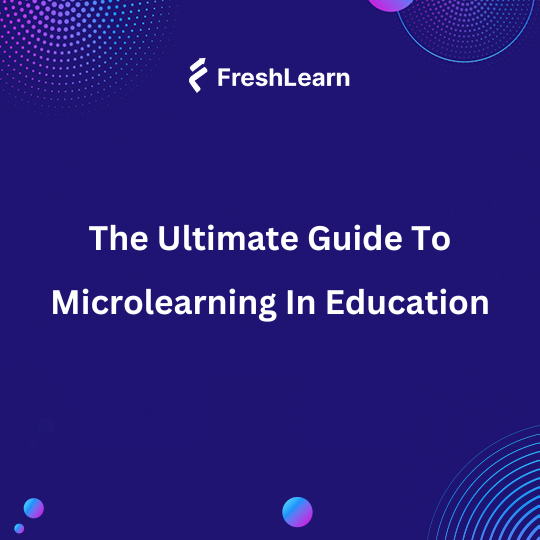
The Ultimate Guide To Microlearning In Education
In today's crazy busy world, where our attention is pulled in a million directions and time feels like it's always running out, traditional learning methods just aren't cutting it anymore.
That's where microlearning steps in. You can say that microlearning is the superhero of education. You ask, why? Well, it delivers tiny easy-to-digest chunks of knowledge that you can gobble up whenever and wherever you want.
So, today's blog is all about the world of Microlearning- what it is, why it's awesome, how to use it, and why it's changing the game in education. So, come along for the ride as we uncover the secrets of microlearning!
The Power of Microlearning In Education
Did you know that those quick 10-minute microlearning courses have an 83% completion rate? That's way higher than the usual 20% to 30% for standard courses.
Pretty cool, right? It just shows how awesome those bite-sized lessons are for both learners and teachers. Now, let me break down the benefits for you
Benefits Of Microlearning For Learners
Increased engagement and focus
The potential of microlearning to enthrall and retain students' attention is among its most significant advantages.
Because there are so many distractions in today's society, microlearning modules' brief, concentrated shape helps to prevent information overload and maintain learners' attention.
With microlearning content delivered in small doses, individuals are more likely to stay focused and absorb the material effectively.
Improved knowledge retention
One of the main benefits of microlearning is its ability to improve knowledge retention. By delivering information in short bursts, learners can quickly grasp key concepts without feeling overwhelmed. The repetitive nature of microlearning also reinforces learning, helping to cement new information in the learner's memory over time.
Enhanced accessibility and flexibility
Accessibility and flexibility are also major benefits of microlearning in education. With the rise of mobile technology, learners can access interactive modules anytime, anywhere, making learning more convenient than ever before.
The best part is, that learners get the freedom to interact with the learning content at their own pace, whether they're at home relaxing or on their lunch break.
Self-paced learning opportunities
Moreover, microlearning in education also offers self-paced learning opportunities, allowing individuals to progress through material at a speed that suits their needs.
By using this learning technique, students can easily take control of their education and focus on the subjects where they most need assistance, avoiding content that they are already familiar with.
Benefits Of Microlearning For Creators/Educators:
Efficient delivery of targeted content
With microlearning, educators can target specific content by breaking down larger concepts into smaller and manageable chunks.
This approach is particularly beneficial for complex subjects, as it allows educators to address individual learning needs effectively.
Furthermore, the concise nature of microlearning materials makes them suitable for learners with diverse attention spans and learning styles.
Easier course development and updates
Traditional course development can be time-consuming and rigid, often requiring extensive planning and resources. Whereas, a microlearning course is also easier and much cheaper to produce. It offers a more agile alternative, allowing educators to create and update courses quickly and efficiently.
With modular content, educators can easily adapt to changing curriculum requirements, incorporate new information, or address emerging trends in their field. This flexibility enables educators to stay relevant and responsive to the evolving needs of their students.
Assessment and feedback in smaller chunks
Microlearning in education facilitates continuous assessment and feedback throughout the learning process.
By integrating quizzes, polls, and interactive activities into microlearning modules, educators can gauge student understanding in real-time and provide timely feedback on their progress.
This iterative approach not only helps identify areas of improvement but also encourages active participation and engagement among students.
Additionally, frequent feedback allows educators to personalize learning experiences and tailor instruction to individual student needs, fostering a more supportive and effective learning environment.
How To Design Effective Microlearning Modules?
Designing effective microlearning modules requires careful consideration of learning objectives, content variety, and engagement strategies.
Here are some key steps to create impactful microlearning experiences:
Identify learning objectives
Learning objectives for each module must be clearly defined, aligning with broader goals and adhering to SMART criteria—specific, measurable, achievable, relevant, and time-bound. They serve as guiding beacons, directing educators and learners toward desired outcomes.
Specificity eliminates ambiguity, measurability enables progress assessment, achievability ensures realistic goals, relevance connects objectives to the subject matter, and time-bound criteria set realistic timeframes.
These objectives empower students, providing clear targets and enhancing the effectiveness of instruction.
Focus On A Single Concept Per Module
In educational contexts, maintaining a clear and focused approach within each module is paramount for effective learning outcomes.
Microlearning focuses around a single key concept or skill so that educators can provide learners with a coherent and digestible framework to engage with the material.
This deliberate structuring not only enhances clarity but also guards against overwhelming learners with too much information at once, thus minimizing cognitive overload.
Breaking down complex topics into manageable modules allows for a more gradual progression of learning, enabling students to grasp fundamental concepts before advancing to more intricate ones.
Offer Diverse Content
To effectively engage learners with diverse preferences and learning styles, it's crucial to offer a variety of content formats. Incorporating micro-videos, infographics, gamification, audio snippets, podcasts, and short quizzes caters to different individuals.
Micro-videos appeal to visual learners, infographics simplify complex information, gamification enhances engagement, audio content suits auditory learners, and quizzes aid in self-assessment.
By embracing this diversity, educational materials become more accessible in a engaging and interactive way, thus promoting deeper understanding and retention.
Keeping it concise and engaging
Microlearning in education thrives on brevity and engagement. Use clear and concise language, avoiding unnecessary jargon or complexity.
Employ visually appealing designs to enhance comprehension and retention. Integrate interactive elements like quizzes, simulations, or branching scenarios to boost engagement and reinforce learning.
Microlearning Examples To Inspire You
Question of the day
The "Question of the Day" is a powerful microlearning technique that delivers knowledge in small, digestible pieces. This method presents a single, focused question to learners each day, prompting them to think critically about a particular topic.
The beauty of this approach lies in its simplicity and effectiveness. By posing a question daily, you can keep key information fresh in learners' minds and encourage them to revisit concepts regularly. This repetition strengthens knowledge retention and fosters a culture of continuous learning.
The "Question of the Day" format is versatile and can be adapted to various subjects. It can be used to introduce new ideas, reinforce existing knowledge, or spark discussions and deeper exploration of a topic.
Interactive Quizzes
In the age of short attention spans and busy schedules, microlearning has emerged as a powerful tool for knowledge retention. Interactive quizzes are a perfect example of this approach.
They break down complex topics into bite-sized chunks of information followed by engaging questions. These quizzes can be delivered on mobile devices or during short breaks, making learning accessible and convenient.
The interactive nature, with elements like gamification and immediate feedback, keeps learners motivated and reinforces knowledge application. This allows for quick knowledge checks and targeted practice, ensuring information is absorbed and readily available when needed.
Pro Tip: FreshLearn can help you turn your boring lecture into an enjoyable experience with games and interesting content. Learners will stay motivated and engaged, wanting to learn more and complete your course!
Microlearning videos
In our fast-paced world, attention spans are shrinking, and free time is a precious commodity. This is where microlearning videos come in. These short, focused videos are perfect for busy individuals who want to learn something new without a big time commitment.
Imagine this: You have a spare five minutes between meetings. Instead of scrolling through social media, you could whip out your phone and watch a microlearning video on a new productivity technique. These bite-sized lessons can be consumed on the go, during your commute, or even while waiting in line for coffee.
The beauty of microlearning videos lies in their ability to break down complex topics into easily digestible chunks. They typically focus on a single learning objective, using clear and concise language with engaging visuals.
This makes them perfect for refreshing your memory on a forgotten skill or acquiring a new one quickly.
Infographics
Another way to implement microlearning is through infographics. An infographic condenses a complex topic into a visually appealing format. Charts, graphs, icons, and illustrations break down information into clear, bite-sized pieces. This makes it easier for learners to grasp key concepts and retain knowledge.
Infographics are perfect for people who are busy and want to learn on the go because they can be quickly seen. They can be rapidly examined before a meeting, skimmed through on a phone during a coffee break, or flipped through while driving.
Knowledge retention is further enhanced by infographics' captivating quality. Information given in an engaging visual manner has a higher chance of being remembered by the audience.
If an infographic piques an interest in a subject, it can compel learners to study more about it.
Micro podcasts
Micro podcasts are just like regular podcasts but condensed to a much shorter format. Episodes typically range from a few minutes to around 20 minutes, allowing you to learn something new during your commute while waiting in line, or even during your lunch break.
This brief format makes micro podcasts ideal for busy individuals who want to learn on the go.
The content of micro podcasts can vary widely, covering anything from professional development tips and historical anecdotes to language lessons and scientific discoveries.
With a wide range of topics available, there's a micro podcast out there to satisfy almost any curiosity.
Wrapping Up
Microlearning is a super cool way to learn stuff. It's like getting bite-sized nuggets of knowledge that are easy to understand and remember.
This works incredibly well; it's not simply a trend.
Microlearning can be useful for both teachers and students, whether you're a teacher seeking fresh techniques or a student preparing for an exam.
You're sure to discover something you enjoy among the several forms available, which include quizzes and quick podcasts.
The best part? You can learn anything, anywhere, anytime – on the bus, waiting in line, whenever! With microlearning, you can be a learning machine and conquer today's world!
Also, if you wish to create amazing quizzes or masterclasses, check out Freshlearn.



